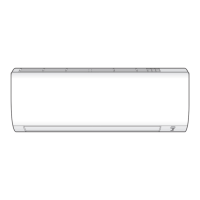Do you have a question about the Daikin ARXN25N6V1B9 and is the answer not in the manual?
Defines WARNING/CAUTION levels and lists safety symbols used in the manual.
Highlights potential hazards during installation like water leakage, electric shock, and fire.
Provides specific installation precautions, including handling gas and drain piping.
Lists included items such as the installation manual and drain plug.
Guidelines for choosing a suitable site considering weight, noise, and accessibility.
Advice for installing the outdoor unit in low ambient temperatures and snowy areas.
Details maximum/minimum pipe length and additional refrigerant requirements.
Illustrates unit dimensions, mounting hole centers, and required clearances.
Instructions for removing and attaching the stop valve cover.
Guidelines for wall height relative to the outdoor unit's airflow path.
Ensuring ground stability and proper securing of the unit with foundation bolts.
Procedures for drain plug installation and considerations for cold areas.
Step-by-step guide for preparing pipe ends for refrigerant connections.
Details on different flaring tools and how to check flare quality.
Important safety notes regarding the flaring process and materials.
Instructions for connecting refrigerant pipes using flare nuts and torque.
Specific torque values for tightening flare nuts and valve caps.
Procedures for removing air from the system and checking for refrigerant leaks.
Guidelines for using vacuum pumps with R410A and detecting leaks.
Detailed steps for vacuum pumping and leak checking the refrigerant circuit.
Instructions for refilling refrigerant into the system.
Specific safety and handling advice when adding R410A refrigerant.
Instructions for applying the fluorinated greenhouse gases label to the unit.
Cautions for handling and bending refrigerant pipes to prevent damage.
Criteria for selecting suitable copper pipes and thermal insulation materials.
Steps to perform pump down for relocating or disposing of the unit.
How to activate forced cooling operation mode for pump down.
Critical safety warnings and hazards associated with pump down operation.
Essential safety precautions for electrical wiring, including circuit breakers and earth leakage.
Details on connecting the main power supply to the unit.
How to connect wires to the terminal board securely and correctly.
Specific advice for connecting single core wires at the terminal block.
Explanation of color coding used for wires in the wiring diagram.
Key to identifying components within the wiring diagram.
Steps for performing trial operation in cooling or heating modes.
A checklist for verifying proper installation and identifying potential issues.
Defines WARNING/CAUTION levels and lists safety symbols used in the manual.
Highlights potential hazards during installation like water leakage, electric shock, and fire.
Provides specific installation precautions, including handling gas and drain piping.
Lists included items such as the installation manual and drain plug.
Guidelines for choosing a suitable site considering weight, noise, and accessibility.
Advice for installing the outdoor unit in low ambient temperatures and snowy areas.
Details maximum/minimum pipe length and additional refrigerant requirements.
Illustrates unit dimensions, mounting hole centers, and required clearances.
Instructions for removing and attaching the stop valve cover.
Guidelines for wall height relative to the outdoor unit's airflow path.
Ensuring ground stability and proper securing of the unit with foundation bolts.
Procedures for drain plug installation and considerations for cold areas.
Step-by-step guide for preparing pipe ends for refrigerant connections.
Details on different flaring tools and how to check flare quality.
Important safety notes regarding the flaring process and materials.
Instructions for connecting refrigerant pipes using flare nuts and torque.
Specific torque values for tightening flare nuts and valve caps.
Procedures for removing air from the system and checking for refrigerant leaks.
Guidelines for using vacuum pumps with R410A and detecting leaks.
Detailed steps for vacuum pumping and leak checking the refrigerant circuit.
Instructions for refilling refrigerant into the system.
Specific safety and handling advice when adding R410A refrigerant.
Instructions for applying the fluorinated greenhouse gases label to the unit.
Cautions for handling and bending refrigerant pipes to prevent damage.
Criteria for selecting suitable copper pipes and thermal insulation materials.
Steps to perform pump down for relocating or disposing of the unit.
How to activate forced cooling operation mode for pump down.
Critical safety warnings and hazards associated with pump down operation.
Essential safety precautions for electrical wiring, including circuit breakers and earth leakage.
Details on connecting the main power supply to the unit.
How to connect wires to the terminal board securely and correctly.
Specific advice for connecting single core wires at the terminal block.
Explanation of color coding used for wires in the wiring diagram.
Key to identifying components within the wiring diagram.
Steps for performing trial operation in cooling or heating modes.
A checklist for verifying proper installation and identifying potential issues.
| Technology | Inverter |
|---|---|
| Cooling Capacity | 2.5 kW |
| Refrigerant | R32 |
| Noise Level (Indoor Unit) | 19 dB(A) |
| Indoor Unit Weight | 9 kg |
| Power Supply (V) | 220-240 V |
| Power Supply (Hz) | 50 Hz |












